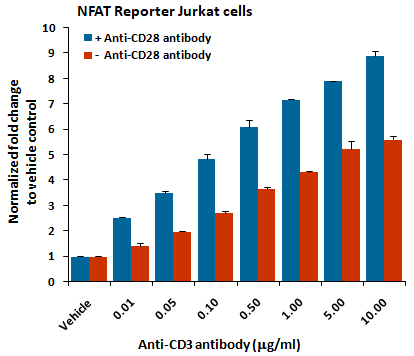Anti-MAP Kinase, Activated (Diphosphorylated ERK-1&2) Monoclonal Antibody (Clone: MAPK-YT)
Shipping Info:
For estimated delivery dates, please contact us at [email protected]
| Amount : | 100 μg/vial |
| Isotype : | Mouse IgG1 |
| Purification : | Ascites |
| Content : | Mouse ascites fluid, 1.2% sodium acetate, 2mg BSA, with 0.01mg NaN3 as preservative. Reconstitute : Add 1ml of PBS buffer will yield a concentration of 100ug/ml. |
| Storage condition : | At -20˚C for one year. After reconstitution, at 4˚C for one month. It can also be aliquotted and stored frozen at -20˚C for a longer time. Avoid repeated freezing and thawing. |
| Gene : | Mapk3 |
| Gene ID : | 50689 |
| Uniprot ID : | P21708 |
| Alternative Name : | Mitogen-activated protein kinase 3; MAP kinase 3; MAPK 3; 2.7.11.24; ERT2; Extracellular signal-regulated kinase 1; ERK-1; Insulin-stimulated MAP2 kinase; MAP kinase isoform p44; p44-MAPK; MNK1; Microtubule-associated protein 2 kinase; p44-ERK1; Mapk3; Erk1, Prkm3 |
| Immunogen Information : | A synthetic peptide containing 11 amino acids, HTGFLTpEYpVAT, corresponding to the phosphorylated form of ERK-activation loop conjugated to KLH. |
In mammalian cells, a variety of extracellular stimuli generate intracellular signals that converge on a limited number of so-called mitogen-activated protein(MAP) kinase pathways. The central core of each MAP kinase(MAPK) pathway is a conserved cascade of 3 protein kinases: an activated MAPK kinase kinase(MAPKKK) phosphorylates and activates a specific MAPK kinase(MAPKK), which then activates a specific MAPK. Mek1/2 MAPK kinases are essential for mammalian development, homeostasis, and Raf-induced hyperplasia. Germline mutations in genes within the MAPK pathway cause cardio-facio-cutaneous syndrome.
Western blot : 0.25-0.5μg/ml; Immunohistochemistry(Paraffin-embedded Section) : 0.4-1μg/ml; Immunocytochemistry : 1μg/ml
For Research Use Only. Not for use in diagnostic/therapeutics procedures.
| Subcellular location: | Nucleus |
| Post transnational modification: | Phosphorylated upon FLT3 and KIT signaling. Ligand-activated ALK induces tyrosine phosphorylation (By similarity). Dephosphorylated by PTPRJ at Tyr-205 (By similarity). Dually phosphorylated on Thr-203 and Tyr-205, which activates the enzyme. |
| Tissue Specificity: | Highest levels within the nervous system, expressed in different tissues, mostly in intestine, placenta and lung. |
| BioGrid: | 248427. 4 interactions. |
|
There are currently no product reviews
|

















.png)











